- Submissions

Full Text
Psychology and Psychotherapy: Research Studys
Language, Theory of Mind, Bilingual Minority Children
Hristo Kyuchukov*
University of Silesia, Katowice, Poland
*Corresponding author: Hristo Kyuchukov, University of Silesia, Katowice, Poland
Submission: March 23, 2023Published: April 14, 2023

ISSN 2639-0612Volume6 Issue5
Abstract
The two classical Theory of mind tests with two non-verbal Theory of mind test are offered to bilingual minority children In Bulgaria. Together with the theory of mind tests also a language test (wh-test with the mental state verb “say”) and evidentiality test is offered. The hypothesis of the study is to check if between the four theory of mind tasks and the language task is there any correlation. In total 120 children (60 Roma and 60 Turkish children) divided in three age groups: 3;6-4;0 years old, 4;1-4;6 years old and 4;6-5;0 years old. In each age group there are 20 children form each ethnicity. The children are tested in their mother tongue (Romani and Turkish) and in Bulgarian as their L2. The hypothesis tested in carrying out the study, namely that the knowledge of grammatical categories is a factor which helps the bilingual children to understand the Theory of Mind was partially proven. In Bulgarian as their L2 the results of the children are very low, most probably because they did not acquire the knowledge on the wh-questions and evidentiality in their second school language and it seems that the TOM tasks are also still difficult for them. The results in mother tongue show that the knowledge of the children of the wh-questions helps them to understand the TOM 1 test, which is on Unexpected Content, as well as the nonverbal tests. The comprehension of evidentiality test in the mother tongue plays an important role in the performance of the TOM 1, TOM 3-nonverbal and TOM 4-nonverbal tests. Age plays a statistically significant role in the performance of the TOM 3-nonverbal and TOM 4-nonverbal tests
keywordsTheory of mind; Minority children; Bilingualism; Bulgaria
Introduction
The present paper presents the finding of an empirical study on the cognitive development of children from two large minority groups exist in Bulgaria: Turks and Roma. The Turkish community is much better integrated into Bulgarian society, while the Roma still live segregated in ghetto types of settlements. The socialization of children in these two communities in a way differs. The Turkish families are usually a nuclear family-mother, father and the child (similar to the Bulgarian family). Very rarely, the young family will live with their parents, and in the house, there will be also grandparents present, while the Roma live in extended families, where all the members of the extended family and the community take care of the young children. In Turkish families the children are exposed to children’s books in Bulgarian and in Turkish, they have access to internet, iPad and many modes of new technology. In Roma families in most cases, children’s books do not exist and the children do not have so much access to internet, iPhones, etc. The language socialisation of the young children in both communities differs significantly. In the Turkish community, the language socialisation is done through children’s books, toys and conversations with the parents. In the Roma community, the socialisation of the children is done through conversing with the extended family members through songs, fairy tales, language games, jokes. The paper centres on using the ‘Theory of Mind’ to assess a select group of bilingual minority children and their contrastive cognitive development.
Theory of Mind
The way the cognitive abilities of the children in the two communities also differ. They obtain information and knowledge about their surrounding world in different ways and channels. The Theory of Mind, according to Perner [1] is “the name of the research area that investigates out folk psychological concepts for imputing mental states to others and ourselves: what we know, think, want, feel, etc.” Or in other words, the Theory of Mind (TOM) is the ability of the human being to understand other people’s intentions, desires, and beliefs. The children develop the understanding of other persons’ intensions in their early childhood; however the question is: do all the children from all cultures develop this ability at the same age? Do the monolingual and bilingual children develop the ability of understanding other peoples’ intentions in the same way, at the same age? What are the factors which helps the process of understanding of intentions and desires of the surrounding culture and people in it? These are some of the research questions which the scientists from all over the world have been exploring over several decades now.
The background to the Theory of Mind (TOM) lies in the fundamental works of Piaget from early 1920s and 1930s, where in a series of publications [2-4], he examined children’s understanding of the physical world. During the second and third year of their lives, children show interest in their feelings, wishes, mental states, and conversations with them about their behaviour show that they, in their cognitive development, increase their understanding of TOM. The interest in children’s understanding of their own mental life started in the 1980s and has continued [5], One of the problems which needs further investigation is how bilingual children understand TOM and how they differ from monolingual children. Over the past decade, a number of publications have been published on this question [6-9] although there is still there no definite answer regarding this question.
Methodology of the study
Table 1:The total number of the children in the study.

The present research was carried out in 2010 in north-eastern
Bulgaria with 120 bilingual children (60 Turkish and 60 Romani
speaking children) between the age of 3;6-5;0 years old. The
Turkish children live in a small town and the Roma children live
in a village. All of them attend kindergarten and they speak their
mother tongue and to some extent Bulgarian as well, which is
their second language. The total number of children in the study is
given in Table 1. The children were given 4 TOM tasks: two classic
False Belief tasks known from previous studies on Theory of Mind
(Unexpected Content and Change of Location) and two non-verbal
Theory of Mind tests with series of pictures:
TOM 1 Task - Unexpected Content
TOM 2 Task - Change of Location
TOM 3 Task - non-verbal TOM task
TOM 4 Task - non-verbal TOM task
The language task comprised a test of wh-questions with 8 items
and a test of evidentiality, also with 8 items. The wh-questions are
used with the mental state verb “to say”, as shown in the following
example:
The child said he paints his brother, but he painted clouds. What
did the child say that he is painting? The children were tested by
trained representatives of the communities and by the researcher.
The following hypothesis is examined in this study:
A. The knowledge of the language of grammatical categories
is a factor which helps bilingual children better understand the
Theory of Mind.
Result
In mother tongue
First, how did the children understand the TOM 1 task in their mother tongue? The TOM 1 task is the Unexpected Content task. This is shown in Figure 1. From the figure, it is evident that the Roma children score better than the Turkish children, which means that the Roma children are better in understanding and performing this task. The influence of the factor mother tongue of children on raw scores on the TOM 1 Test in their L1 is statistically significant (F=18,53; p<0,00004). The effect size is medium (η2=0,15). This is shown in Figure 1. Analysing the results from the language task, we see that there is an influence of the factor comprehension of whquestions in the mother tongue on raw scores on the TOM 1 test in the mother tongues of the children, and it is statistically significant (F=4,61; p<0,03). However the Effect size is small (η2=0,04). This can be seen in Figure 2. However, the influence of interaction between the factors mother tongue of children and comprehension of wh-questions in their mother tongues on raw scores on the TOM 1 test in mother tongue is not statistically significant. There is no statistically significant influence of the factor comprehension of wh-questions in the mother tongue on raw scores on the TOM 2 test in the mother tongue. The influence of interaction between factors mother tongue of children and comprehension of wh-questions in the mother tongue on raw scores on the TOM 2 test in the mother tongue is likewise not statistically significant.
Figure 1:Influence of the mother tongue of children on the raw scores on the TOM 1 test in their mother tongue.
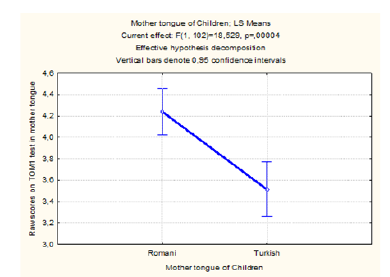
Figure 2:Influence of the factor comprehension of Wh-questions in the mother tongue on raw scores on the TOM 1 test in the mother tongue.
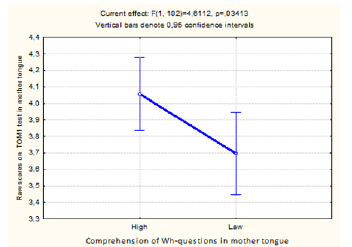
Figure 3:Influence of the mother tongue on the raw scores on TOM 3-nonverbal test.
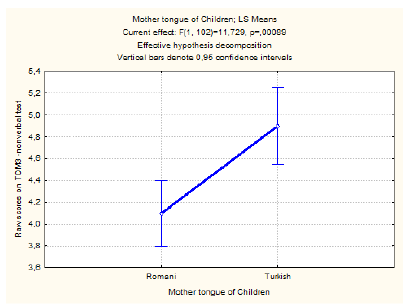
However, the influence of the factor mother tongue of children on the raw scores on the TOM 3-nonverbal test in the mother tongue is statistically significant (F=11,73; p<0,00089). The effect size is small (η2= 0,10). Figure 3 shows the results. However, the influence of the factor comprehension of wh-questions in the mother tongue on raw scores on the TOM 3-nonverbal test is not statistically significant. The influence of interaction between factors comprehension of wh-questions in the mother tongue and mother tongue of children on raw scores on the TOM 3-nonverbal test is likewise not statistically significant. The influence of the factor mother tongue of children on the raw scores on the TOM 4-nonverbal test in the mother tongue is statistically significant (F=6,05; p<0,015). But the effect size is small (η2= 0,06). This is displayed in Figure 4. The influence of the factor comprehension of wh-questions in the mother tongue on the raw scores on TOM 4-nonverbal test is not statistically significant. The influence of the interaction between the factor’s comprehension of wh-questions in the mother tongue and the mother tongue of children on raw scores on the TOM 4-nonverbal test is not statistically significant.
Figure 4:Influence of mother tongue on the raw scores on the TOM 4-nonverbal test.
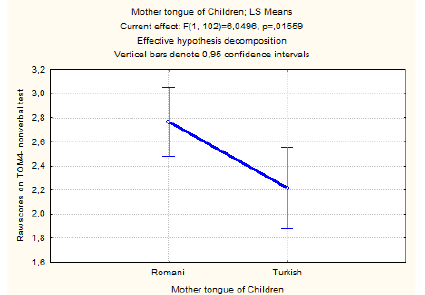
Figure 5:Influence of age group on raw scores on TOM 1 test in mother tongue.
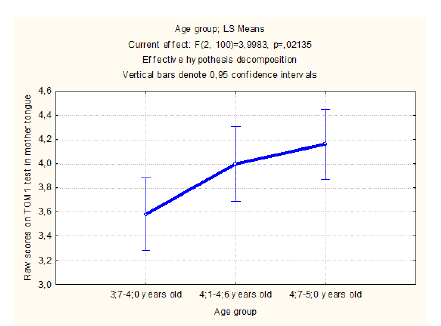
Let us see how the children perform the Tests by age groups. This will be shown in the following figures. Figure 5 shows that the influence of the factor age group on the raw scores on the TOM 1 Test in the mother tongue is statistically significant (F=3,99; p<0,02), but the effect size is small (η2= 0,07). The influence of factor comprehension of wh-questions in the mother tongue on the raw scores on TOM 1, TOM 2, TOM 3 non-verbal tests in the mother tongue are not statistically significant. The influence of interaction between the factor’s comprehension of wh-questions in the mother tongue and age group on raw scores on TOM 1, TOM 2, TOM 3 non verbal tests are again not statistically significant. The statistically significant differences of age groups are shown by the performance in the TOM 4 non-verbal test. This can be observed in Figure 6. The influence of the factor age group on raw scores on the TOM 4-nonverbal test in the mother tongue is statistically significant (F=8,84; p<0,0003). The effect size is medium (η2= 0,15). The influence of the factor comprehension of wh-questions in the mother tongue on raw scores on the TOM 4-nonverbal test as well as the influence of interaction between factors comprehension of wh-questions in mother tongue and age group on raw scores on the TOM 4-nonverbal test is not statistically significant. The influence of the factor comprehension of evidentiality in the mother tongue on the raw scores on TOM 1 and TOM 2 tests in the mother tongue are not statistically significant. The influence of the factor mother tongue of children on the raw scores on TOM 1 and TOM 2 tests in the mother tongue are not statistically significant. The influence of interaction between factors comprehension of evidentiality in the mother tongue and the mother tongue of children on the raw scores on TOM 1 and TOM 2 tests in the mother tongue are not statistically significant. However, significant differences can be found in the performance of the TOM 3-nonverbal test and this is shown in Figure 7.
Figure 6:Influence of age group on raw scores on TOM 4-nonverbal test.
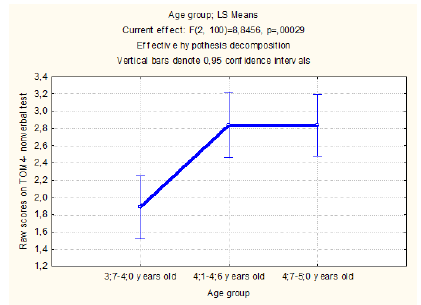
Figure 7:Influence of the mother tongue on raw scores on the TOM 3-nonverbal test.

The influence of the factor mother tongue of children on the raw scores on the TOM 3-nonverbal test is statistically significant (F=4,04; p<0,05). The effect size is small (η2= 0,04). However, the influence of the factor comprehension of evidentiality in the mother tongue on the raw scores on the TOM 3-nonverbal and TOM 4-nonverbal tests is not statistically significant. The same holds for the influence of the factor mother tongue of children on the raw scores on the TOM 4-nonverbal test, and the influence of interaction between the factor’s comprehension of evidentiality in the mother tongue and mother tongue of children on raw scores on the TOM 4-nonverbal test in the mother tongue. The children with Turkish as a mother tongue show better results than the Romanispeaking children. Let us see now what the connection is between the comprehension of evidentiality and the raw score on the TOM 1 test. The results are shown in Figure 8. As evident from the figure, the influence of the factor comprehension of evidentiality in the mother tongue on raw scores on the TOM 1 test is statistically significant (F=9,35; p<0,002), but the effect size is small (η2= 0,09). The influence of the factor comprehension of evidentiality in the mother tongue on the raw scores on the TOM-2 test is not statistically significant. The influence of the factor age group on raw scores on TOM 1 and TOM 2 tests is not statistically significant, as there are no statistically significant differences in the influence of interaction between the factors comprehension of evidentiality in the mother tongue and age group on the raw scores on TOM 1 and TOM 2 tests in the mother tongue.
Figure 8:Influence of comprehension of evidentiality in the mother tongue on raw scores on the TOM 1 test.
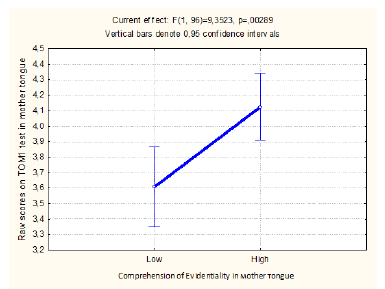
How did the children perform in the TOM 3-noverbal and TOM 4-nonverbal tests in connection with evidentiality? Figure 9 shows that the influence of the factor comprehension of evidentiality in the mother tongue on the raw scores on the TOM 3-nonverbal test is statistically significant (F=7,77; p<0,006). The effect size is small (η2=0,07). Figure 10 shows that the influence of factor age group on raw scores on the TOM 3-nonverbal test is statistically significant (F=3,73; p<0,02), but the effect size is small (η2=0,07). However, the influence of interaction between the factor’s comprehension of evidentiality in the mother tongue and age group on raw scores on the TOM 3-nonverbal test in the mother tongue is not statistically significant. Figure 11 shows that the influence of the factor comprehension of evidentiality in the mother tongue on the raw scores on the TOM 4-nonverbal test is statistically significant (F=4,19; p<0,04). The effect size is small (η2=0,04). The influence of factor age group on raw scores on the TOM 4-nonverbal test is statistically significant (F=8,32; p<0,0005) and the effect size is medium (η2= 0,15). This is shown in Figure 12. The influence of interaction between the factor’s comprehension of evidentiality in the mother tongue and age group on raw scores on the TOM4- nonverbal test in the mother tongue is not statistically significant.
Figure 9:Influence of comprehension of evidentiality in the mother tongue on raw scores on the TOM 3-nonverbal test.
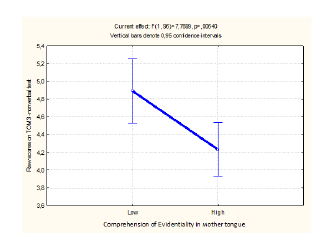
Figure 10:Influence of age group on the raw scores on TOM 3-nonverbal test.

Figure 11:Influence of comprehension of evidentiality in the mother tongue on raw scores on TOM 4-nonverbal test.
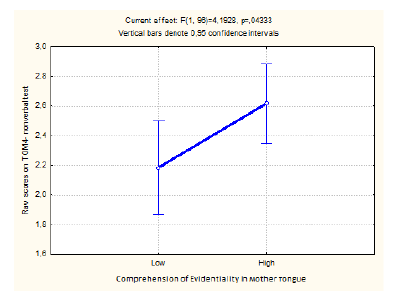
Figure 12:Influence of age group on the raw scores on TOM 4-nonverbal test.
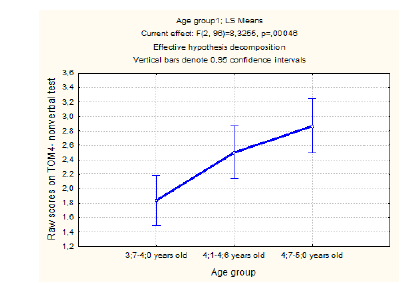
Result
In Bulgarian
The children were tested in Bulgarian as well and in this section, I present the results of the children in Bulgarian. Figure 13 shows the influence of the age group on raw scores on the TOM 1 test in the Bulgarian language. The influence of the factor age group on the raw scores on the TOM 1 test in Bulgarian is statistically significant (F=6,11; p<0,003) and the effect size is medium (η2=12). However, the influence of the factor comprehension of wh-questions in Bulgarian on the raw scores on the TOM 1, TOM 2 and TOM 3-nonverbal test is not statistically significant; nor is the influence of the factor age group on raw scores on the TOM 2 and TOM 3-nonverbal test statistically significant. The influence of interaction between the factors age group and comprehension of wh-questions in Bulgarian on the raw scores on the TOM 2 and TOM 3-nonverbal test are likewise not statistically significant. Figure 14 shows that the influence of the factor comprehension of whquestions in Bulgarian on the raw scores on the TOM 4-nonverbal test is statistically significant (F=7,95; p<0,006). The effect size is small (η2=0,08). However, the influence of the factor age group on the raw scores on the TOM 4-nonverbal test is not statistically significant. The influence of interaction between the factors age group and comprehension of wh-questions in Bulgarian on raw scores on the TOM 4-nonverbal test is not statistically significant.
Figure 13:Influence of age group on the raw scores on TOM 4-nonverbal test.
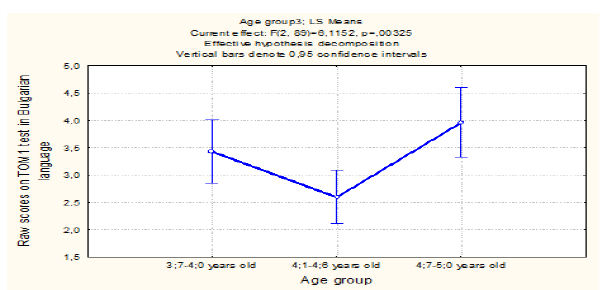
Figure 14:Influence of the factor comprehension of wh-questions in Bulgarian on the raw scores on the TOM 4-nonverbal test.
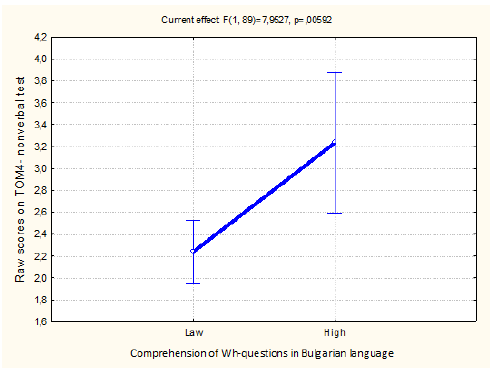
The influence of the factor comprehension of evidentiality in Bulgarian language on the raw scores on TOM 1, TOM 2 and TOM 3-nonverbal tests in Bulgarian is not statistically significant. The influence of the factor mother tongue of children on the raw scores on TOM 1, TOM 2 and TOM 3-nonverbal tests in Bulgarian is likewise not statistically significant. The influence of interaction between factors mother tongue and comprehension of evidentiality in Bulgarian on the raw scores on TOM 1, TOM 2 and TOM 3-nonverbal tests is not statistically significant. However, there is an influence of the factor mother tongue of the children on the TOM 4-nonverbal test - the differences are not statistically different (F=4,38; p<0,04). The effect size is small (η2=0,04). This can be seen from Figure 15. The influence of the factor comprehension of evidentiality in Bulgarian on the raw scores on TOM 1, TOM 2 and TOM 3-nonverbal tests in Bulgarian is not statistically significant. The influence of the factor age group on the raw scores on TOM 1, TOM 2 and TOM 3-nonverbal tests in Bulgarian is not statistically significant. The influence of interaction between the factors age group and comprehension of evidentiality in Bulgarian on the raw scores on TOM 1, TOM 2 and TOM 3-nonverbal tests is not statistically significant. What is the influence of the factor age group on the raw scores on the TOM 4-nonverbal test in Bulgarian? Figure 16 shows the findings. The influence of the factor age group on the raw scores on the TOM 4-nonverbal test in Bulgarian is statistically significant (F=3,47; p<0,04). The effect size is small (η2=0,07). How did the children comprehend evidentiality in Bulgarian? This is shown in Figure 17. The influence of the factor comprehension of evidentiality in Bulgarian on the raw scores on the TOM 4-nonverbal test in Bulgarian is statistically significant (F=7,09; p<0,009). The effect size is small (η2=0,07).
Figure 15:Influence of the factor mother tongue of children on TOM4-nonverbal test.

Figure 16:Influence of the factor age group on the raw scores on the TOM 4-nonverbal test in Bulgarian.
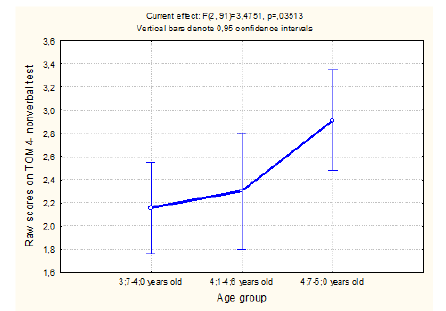
Figure 17:Influence of the factor comprehension of evidentiality in Bulgarian on the raw scores on the TOM 4-nonverbal test in Bulgarian.
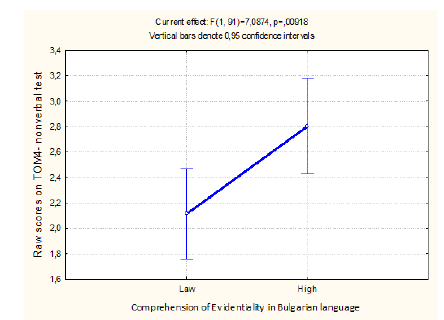
Discussion
All the research findings provide a basis for the following discussion and conclusions. The children perform much better in the tests in their mother tongue than in Bulgarian. The Roma children are better in performing TOM 1 test in Romani. The comprehension of the wh-questions influences the performance of the TOM 1 test. However, the Turkish children are better in performing the TOM 3-nonverbal test in Turkish. In the performance of the TOM 4-nonverbal test, there is an influence of the mother tongue, and the Roma children show better results in performing this particular test. Age plays an important role in the performance of the TOM 1 and TOM 4-nonverbal tests. In the evidentiality test and its influence on the performance of the TOM tests, the following trends are observed. The mother tongue influences the performance of the TOM 3-nonverbal test and the Turkish children are better than Roma children. The comprehension of evidentiality test in the mother tongue plays an important role in the performance of the TOM 1, TOM 3-nonverbal and TOM 4-nonverbal tests. Age plays a statistically significant role in the performance of the TOM 3-nonverbal and TOM 4-nonverbal tests. In performance of the tests in Bulgarian, the children showed the following results. In the relations between the comprehension of the wh-questions and the TOM tests, age is an important factor only in the performance of the TOM1 test. Between the groups, there are statistically significant differences. However, there is no influence of the comprehension of wh-questions on the TOM tests in Bulgarian in general. In regard to the relation between the evidentiality tests and the TOM tests in Bulgarian, the children with Romani as mother tongue show better results in the performance of the TOM 4-nonverbal test. In the performance of this test, the age factor plays an important role. The comprehension of the evidentiality in Bulgarian influenced the performance of the TOM 4 non-verbal test in Bulgarian.
Concluding Thoughts
In conclusion, it is possible to state that the goal of the study has been partially achieved. The hypothesis tested in carrying out the study, namely that the knowledge of grammatical categories is a factor which helps the bilingual children to understand the Theory of Mind was partially proven. The results show that the knowledge of the children of the wh-questions helps them to understand the TOM 1 test, which is on Unexpected Content, as well as the nonverbal tests. I cannot state that the Turkish or Roma children are better in performing the wh-questions and the TOM tasks in their mother tongue. The knowledge of evidentiality also influences the performance of TOM tasks and again the same three TOM tasks are performed successfully. The results suggest that research should be repeated with the nonverbal TOM test. In the research in the mother tongues of the Turkish and Roma children, good results are evident between the comprehension of wh-questions and evidentiality and the influence on understanding of the two nonverbal TOM tests. In the verbal tests, only the Unexpected Content shows some connection with the knowledge of language. In Bulgarian the results of the children are very low, most probably because they did not acquire the knowledge on the wh-questions and evidentiality in their second school language, i.e. Bulgarian, and it seems that the TOM tasks are also still difficult for them. In some cultures, where the oral tradition plays a strong role in the cognitive and language development of the children, such as in Roma culture, it seems the classic Theory of Mind tests are not very appropriate or of much assistance.
References
- Perner J (1995) Theory of mind. In: Bennett M (Ed.), Developmental Psychology, Psychology Press, Philadelphia, USA, pp. 205-230.
- Piaget J (1926) The language and thought of the child, Kegan Paul Trench & Trubner, London, UK, p. 288.
- Piaget J (1928) Judgement and reasoning in the child, Kegan Paul Trench & Trubner, London, UK, p. 260.
- Piaget J (1929) The child’s conception of the world, Kegan Paul Trench & Trubner, London, UK, p. 379.
- Dunn J (1995) Mindreading and social relationship. In: Bennett M (Ed.) Developmental Psychology, Psychology Press, Philadelphia, USA, pp. 55-71.
- Kyuchukov H (2010) Cognitive development and theory of mind in bilingual children. In: Bokus B (Ed.), Studies in the Psychology of Language and Communication, Matrix, Warsaw, Poland, pp. 211-225.
- Kyuchukov H (2011) Theory of mind and wh-questions in Bulgarian bilingual children. In: Stoyanova J, Kyuchukov H (Eds.), Psychology Linguistic/ Psychology and Linguistics, Prosveta, Sofia, Bulgaria, pp. 169-182.
- Kyuchukov H (2012) Cognitive development and theory of mind of bilingual children. In: Milovanova LA (Ed.), Actual Problems of Linguodidactics and Linguistics, Paradigm, Russia, pp. 76-81.
- Kyuchukov H, De Villiers J (2009) Theory of mind and evidentiality in Romani Bulgarian bilingual children. Psychology of Language and Communication 13(2): 21-34.
© 2023 Hristo Kyuchukov, This is an open access article distributed under the terms of the Creative Commons Attribution License , which permits unrestricted use, distribution, and build upon your work non-commercially.
 a Creative Commons Attribution 4.0 International License. Based on a work at www.crimsonpublishers.com.
Best viewed in
a Creative Commons Attribution 4.0 International License. Based on a work at www.crimsonpublishers.com.
Best viewed in 







.jpg)






























 Editorial Board Registrations
Editorial Board Registrations Submit your Article
Submit your Article Refer a Friend
Refer a Friend Advertise With Us
Advertise With Us
.jpg)






.jpg)














.bmp)
.jpg)
.png)
.jpg)










.jpg)






.png)

.png)



.png)






